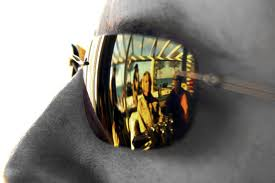
Changing Our Minds
One of the ways that we can continue to develop our awareness is by working to eliminate barriers that keep us tuned into the outside world as an observer rather than as a part of what we observe. We go about our day perceiving the physical world and thinking thoughts about it, but we do not feel connected to it save through our five senses. It is not easy to turn our awareness so that we gradually reduce that sense of separateness though we certainly can do so. Today I would like to continue to share thoughts about how we can do this if we so choose.
Every day we go to sleep to rest and recharge ourselves for the next day. When I awoke this morning, the first thing I notice was – I am ... but it is not instantaneous, even though the cobwebs of sleep that held us close are, as we come awake, thinner and easily snapped. I felt like I was pulling myself back into my body, a cloud of ether coalescing and merging with my physical self, though I do not remember making the decision to return.
It took only a few moments for my mind to engage and recognize itself among the vibrations. Outer and inner eyes seeing together until my two eyes take over and the objects in the room materialize out of the sea of energy dancing before me. If I do not shift out of this space, if I do not focus my attention through my physical senses, I can revel in the feeling of oneness connectedness to what I can see. Today I awoke quickly, due to circumstances, and this is typical. Most days we awaken quickly and get right into the start of our day, though sometimes it is a leisurely, almost blissful shift into wakefulness.

We barely notice the transition, let alone acknowledge it, except on those rare occasions when we allow ourselves to languish in the peaceful glow of the moment. These are the times when it is easiest to re-enter a dream we were having and when the normal separateness we feel from the world around us is less evident. Unfortunately, more often than not, thoughts race in and we start to think about what we have to or want to do when we get up. We are then “up and at’em” before realizing it and that moment passes.
These moments are transition states between one state of awareness and another. For most, this is a time when the veil between the rational mind and our “inner self” is at its thinnest. There are many moments like this in our lives. We miss most of them, passing them by as we focus virtually all of our attention on the external world. We allow or Rational Mind (RM) to focus on the physical, external aspects of our reality, albeit without our conscious consent, that creates the veil that blocks our awareness.
We have many opportunities to pierce the veil I referred to every day, just as we have the opportunity to see behind the veil when we awaken in the morning. I have looked at from several angles and touched on in a number of essays and for a good reason. In a number of them, I have spoken about how our mind creates blocks and filters that keeps us trapped outside of ourselves. Experiences program our minds to perceive what we want to perceive and what we focus on is our physicality. This is the main problem with developing our awareness. To change this we must change our focus. We may not be able to pierce the veil quickly, but we can start thin it out.
One of the main reasons our focus remains on our physical senses is because we find it more appealing, for it is not that we cannot perceive behind the veil, we have trained ourselves to desire other experiences more. The glamour of the physical world is certainly compelling and most of our experiences only serve to cement our focus on the external material aspects of our existence. If you truly want to break its hold, what is required is effort and commitment. As I have said before, it is something you must want to do for it is not likely to happen otherwise.
Over the course of these essays, I have covered a number of ways we can expand our awareness. One of the most significant is through working on our beliefs. Our beliefs are part of the program that guides our choices and experiences in life. We struggle with the veil, which is our own Rational Mind (RM) because we take it as us, which it is not. It blocks us because we have permitted it to.
For example, this short passage from the “Limiting Aspects of the RM” (1):
How we view that person in the future then becomes a matter of not just how they act, but is subject to how we perceived them in the first encounter, and the strength of the quality in us that led to the perception. If we are very fearful of a person or thing that exhibits certain qualities to us, we are fearful of anyone or anything that exhibits them regardless of whether they actually possess them or not. The same would apply to the case where we believe in the goodness of someone because of our perception of them. We would likely continue to believe in their goodness even when they are not acting in such a fashion.

We are not able to see people for what they are because of our programmed minds, which react to what we perceive based on how we integrated previous experiences. The same process that leads to this also blocks our ability to perceive beyond the physical. I provided an exercise (2) to help people begin the process of finding out what they believe so they can start to work to rewrite or eliminate beliefs not based on “truth”, those that conflict and those that are simply false.
We are not going to get beyond the limitations of our programmed minds until we start to pay attention to what we think about and to what we “feel”. This is how we get at our programmed rational minds. I devoted a series to this topic and this is from the first of the four parts of it.
From “Active Awareness” (3):
So, how does one go about becoming more actively aware? Well, if we are working or doing what I have spoken to above then what we want to be doing is paying attention to how we feel and what we think in the moment. A great many factors affect our state of mind and our awareness in the moment. I cannot address them all here, so perhaps some practical examples may help.
For instance, if I'm going about my life and something occurs that frustrates me I may not notice a shift in my emotional state because I am not paying attention as my mind is on other things or I choose to ignore it because I deem it irrelevant to what is more important. A little later something else or a couple experiences occur happens and I explode in anger or frustration. I could have been avoided all of this, if I had realized the original shift in my emotional state and had dealt with it when it occurred.
This is a great start for personal growth; however, if one is working to develop their sensitivity to energy or to enhance it, one must do more than just work on limiting beliefs and paying more attention to what they are thinking and feeling. Beyond working on our thoughts, we also must start to practice “no-thinking”. One of the ways we do this is by focusing more on what we are doing in the moment. It is moment by moment that we engage our minds and this is what we want to do less frequently.
From “Active Awareness Series Part 1: Learning to Work with Energy” (4)
A good example would be when I look out and perceive people. If I am have too many thoughts going on, being subjective or judgmental then what I see will be based on those notions rather than what is actually there to be perceived. I made this statement the other day...
When you are out and about today take a little time to just accept what you see, try to not judge anything or anyone regardless of what they are doing or how you perceive it or them. It is not easy to do; however, taking time to suspend judgment is one of the most freeing and cathartic things one can do for themselves.
We create the thoughts in our minds and in a very real way they combine to create a program. The program we create, which is merely a mental construct, is what I refer to as our rational mind, tends to become the sole vehicle we use perceive everything. The consequence of this is that we come to rely on our physical senses and our thoughts as our means of experiencing “reality”. We have looked at how this is the illusion of the constructed "I" and what we can do to start to shift our attention away from our physical senses and the relentless churning of our thoughts. Further complicating our doing are the layers of thoughts we have create the bulk of which occur at the non-conscious or sub-conscious level. A large number of thoughts filter and/or block what we perceive affecting our perceptions and how we react to experiences.
Working on having fewer non-conscious thoughts is part of the key to getting beyond the limits our own minds create for us. This is indeed a challenge as we are not conscious of the all the thoughts that lead to the ones we are conscious of. You may think that this is not possible, I assure you it is. All we have to do is start to reduce how much time we spend running on automatic. You may even think that you do not do it very much; however, if this were so then you would be more sensitive and aware.
We are reactionary, that is to say we react to our experiences rather than act. While this sounds like I am making a distinction where there is no difference I am not. Acting is in the moment, without thinking about what one is going to do, without having an agenda or a destination or a goal save what the moment presents. The future is unpredictable hence trying to set up a particular future based on thinking our way through it is certainly problematic to say the least.

Some of these thoughts are necessary mental processes such as our minds calculating various distances as we walk and physically interact with the world, others are not so necessary. For example, when we observe anything we have a tendency to value it rather than simply observe as this is how we have trained our mind. We need to understand “things” to make a decision, but we do not need to judge everything we observe, and we do if not consciously certain non-consciously. The other thing we do is live in our wants and needs. In the essay “Looking Within” (5), I suggest the following:
The physical reality is a distracting one that keeps our attention focused externally. We base too much on our physical self and attach value to owning things, to building things, to being liked, admired or cared about. We want approval, we want a job so we can afford food and shelter, we want more money, more things and believe that if we continue to pursue them we will find the happiness we seek. We want.... that is our "mind" has us wanting. The problem with this is that it ignores our true inner self.
There are ways to clear the debris from our minds, conscious acts that not only give us practice in thinking differently, our intent sends a message to our minds that starts to realign our thoughts to be less restrictive. Earlier, I mentioned that we should work on not judging the objects of our perception as good or bad or anything in particular.
A way to do this is to look at things differently. The next time you are out stop for a moment somewhere and observe people. Give yourself a moment to clear your mind, take a few breaths to relax and make sure you ground.
Do not observe them by staring at them, gaze at them without focusing your eyes on them. We can do this by not by looking directly at them, rather look past them so that the focal point of our eyes is not on them. Try not to think at all; simply try to look “through” them and beyond them. This reduces our attention to details about them that we might otherwise be inclined to use to “figure them out”, which is just another way of judging them. We want an impression of them, not an impression interpreted by our RM.
Now, since you likely do not know the person you have no way of knowing whether your impressions are true or not; however, that does not matter. Our goal is to change how we observe; this puts our RM off balance and can allow impressions to come through. Everything we do that is different than we normally do forces our mind to integrate new ideas. As you observe them, try to “feel” them rather than think about what kind of person they are. Do not use words to describe them, accept the impressions you get first and then try to put the impressions you get into words, though only if you need to. If you do this, try to find words that fit the impression you are getting. If you find yourself thinking stop, and try again on someone else instead of reinforcing the patterns of old.

The benefit in doing this is in the doing, and not the answer. When we observe this way we tend to do several things that can help to realign the way our mind works. The key elements being:
- We suspend judgments
- We are being less subjective
- We are not concerned about what we may have to do next
I get that these seem trivial matters; they are not. Our minds tend to get into a routine, or ruts, in how it reacts to and process experiences and pretty much anything we can do to break up the routine will be of benefit. You may even come up with your own ideas about how to do this. Bottom line is our minds tend to go on automatic; this does not help our awareness. We want to allow impressions to come to our attention unhindered by interpretation from our RM and the more practice we get at this the better.
In the context of observing people as I explained above, what we are doing is disconnecting our attention from what we observe. The act of decoupling helps because the RM becomes less active, almost passive and this creates “space” for the energy we perceive from others to be observed. There will be time when doing so has you feeling anxious or uncertain, this is your RM’s doing, as it likes what it is familiar with and will try to get you to follow the pattern. Try to ignore this if you can by breathing, grounding and be insistent by carrying on with your new way of doing things.
Doing as I suggest will help; however, an added benefit can be found in actually spending some time reinforcing the idea that all is energy and that energy follows attention. In addition, we do not realize how our mind creates a routine when we observe others. We can change this routine by observing the reactions others have to us when we change our energy. To give you something to try I am including a section of a member exercise from TheTwinPowers.com website. I shared one of the sub-exercises in last week essay called “Intuitive Indulgences” (6), that one being “The Card Game”. That exercise and the one below are from Exercise 8, “Developing Your Awareness” (7).

Ex 8.3 Changing Your Energy
You can do this exercise anytime you are around other people. This exercise is not as simple as the first two because you will need to focus you attention to do it. The scenario I will use is one where you are sitting on a bench or standing in a place where a number of people are close by or are likely to walk past you.
This exercise comes with a caution. When you are working with energy, you must always have as a root concept the idea that whatever we do must be in the best interests of everyone. All save the most adept have issues that can turn a harmless exercise into an act of manipulation, as even a subtle thought can affect the outcome, including non-conscious ones. The consequences grow along with our ability to work with energy. Whenever you work with energy remember to leave others energy alone (this applies to all living things), and second, if you are vulnerable to the energy of others, exercise caution. Those who are vulnerable should consider whether you should do it at all. Come back to it when you are feeling more able to manage any energy that could be present.
Step 1:
Before doing anything take a moment to do a quick meditation to minimize your thoughts, then ground and clear your energy. If you feel able, center yourself as well. Do your best to be calm, relaxed and in an objective state. You do not need to get deep into meditation; just be well grounded and have a clear mind.
Step 2:
Take a moment to feel your energy. You should have meditated a few times by now, and feeling your energy is similar to what we do when we center. You will be looking at shifts in others due to shifts you make.
While you need to know and work with your energy, it is relative; hence, for this exercise the state of your energy is almost immaterial. Notice how big your energy field is before moving on to step three. Do this by imagining you are reaching through your energy field and feel how far it extends.
Step 3:
Observe the people around you and their reactions or lack thereof to you in your current state. Focus your attention on two things, your energy and noticing how people react. Gaze around as blankly as possible to avoid staring at people. Staring will affect their reactions. Keep your energy in the same state by reacting as little as possible for a time, say a couple of minutes.
Step 4:
Shift your energy from its current state to some other one. Use the below list as examples of what to try or try ideas of your own.
- If you energy is calm, try to make the outer edge of it more assertive or edgy.
- Pull your energy in or expand it.
- Imagine you are invisible.
Do this by remembering what what you own energy feels like and then expand it as you did you own in Step 1. Hold this energy state for a few minutes as well.
Step 5:
Observe how people react and try to notice if more people pay attention to you or less. Other reactions to observe are how closely they look at you compared to Step 2.
Step 6:
Try other types of energy, perhaps feelings of sadness or joy, or even anger. Again, hold this energy for a time. You do not need to make your entire aura feel this way, just the outer edge. This will not harm you or make you take on the feeling you are manifesting; it will simply put that feel on the outside of your aura. People tend to react to their first impressions, which in this case will be the outer edge of your aura.
Follow-up
This is just a fun way of breaking away from perceiving ourselves as purely physical. This belief is the illusion painted by the mind and supported by our physical senses. We need to remember that the mind expands when we increase possibilities. We do this when we create new thoughts, they whittle away at strongly held beliefs.

We can open up the closed doors in our minds; peel back the veil bit by bit. All of the actions I have spoken of help to reinforce the idea that we are choosing to change, that the way we have done things are no longer relevant and that we are taking ownership over our minds. Yes, it remains a slow process, but how slow it is depends on how much you invest yourself in the process and the amount of time you spend each day viewing and thinking in a new way.
There are no quick fixes to improving our awareness, to allowing what the hidden to show itself to us. All we can do is try to avoid looking for the next moment, thinking about result and spend our time on now, on expressing ourselves by choice rather than routine. Our thoughts are energy, hence, when we change the way we think and act the energy we put into doing so modifies our mind. It is not rocket science, it is merely taking advantage of the way our minds are constructed and their dynamics.
When you have an intuition do not pass it by through rationalizing why it is not the correct choice. Do not be afraid to take a chance when it feels right, though be careful how much you risk unless you are very sure that it is an intuition you are getting rather than an impulse. Once you learn to hear your intuition, and trust it, more you will be amazed by the experiences you have, what you can learn and especially by what you find yourself capable of doing.
© 2011 Allan Beveridge
Last updated October 19, 2020
References (*- denotes essays only available to site members):
